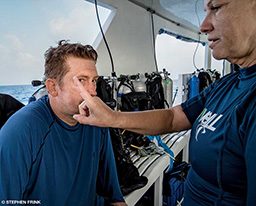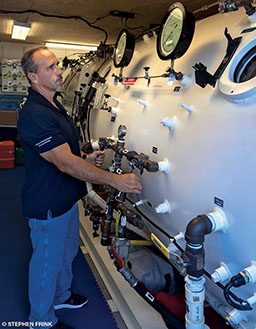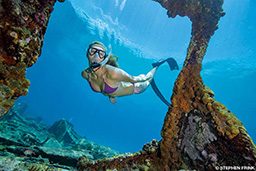I understand that arterial gas embolism (AGE) can manifest like a stroke, with facial droop and cognitive problems. It makes sense that bubbles in the brain could cause such serious symptoms, but I have also heard about facial droop occurring with much less severe dive injuries. How could this happen?
This phenomenon is illustrated by a recent case involving a 46-year-old male diving in Ambon Island, Indonesia. The diver was doing several days of repetitive diving using 32 percent enriched air nitrox. Recent diving days included 50- to 90-foot dives that lasted 60 to 90 minutes. He typically did two or three dives per day. On his fourth day of diving, he did a dive to 93 feet for a total dive time of 51 minutes and then, following a five-hour surface interval, he did a second dive to 50 feet for 41 minutes.

Ten minutes after surfacing from this second dive, he experienced left facial weakness and a contracture of his left hand. He also described his tongue as feeling “numb” and “thick.” Upon further questioning the diver stated that he experienced a significant reverse ear squeeze earlier that day. He was immediately administered oxygen via a mask on the dive boat.
By chance, a neurologist was present on the dive boat and performed a medical evaluation. The physician found that the left facial muscle weakness involved the forehead as well as the lower face. All of the diver’s symptoms except for the “thick” tongue sensation resolved within 30 minutes of breathing 100 percent oxygen. Because of his symptoms and multiday diving history, the dive staff were concerned about decompression illness (DCI) and recommended evaluation by a physician trained in dive medicine.
The differential diagnosis in this case encompasses many nondiving- and diving-related diseases. Given the multiday diving history and rapid onset of symptoms, it is certainly prudent to consider DCI. The anatomical distribution and type of symptoms are not typical for decompression sickness (DCS), however, and without a rapid or uncontrolled ascent, AGE is not likely. Possible non-diving-related maladies include a cerebral vascular accident (CVA) and a transient ischemic attack (TIA), commonly referred to as a stroke and mini-stroke, respectively. These conditions, however, would likely spare the forehead area of weakness and paralysis. Bell’s palsy and inner-ear DCS are also possible, yet this diver’s history of a significant reverse ear squeeze combined with his pattern of symptoms is highly suspicious for another much less commonly discussed diving illness.
Facial baroparesis, also known as alternobaric facial palsy, is an ischemic neurapraxia (a temporary paralysis) of cranial nerve VII. It is caused by impaired Eustachian tube function that leads to persistent overpressurization of the middle ear following a reduction in ambient pressure — i.e., an ascent. The seventh cranial nerve, or facial nerve, runs through a bony canal as it travels through the middle ear. In most people a small part of the nerve enters the middle-ear cavity unprotected by the bony facial canal. As a result, overpressurization in the middle ear can lead to a localized reduction in blood flow to the exposed portion of the nerve. If the reduction in blood flow is severe or persists, the nerve suffers from ischemia. As a result of this ischemia, the motor and sensory functions of the facial nerve are inhibited. The seventh cranial nerve controls the muscles of facial expression and relays taste sensation from part of the tongue. An appreciation of this anatomy and nerve function along with careful consideration of the symptoms and diving history facilitate diagnosis of this condition.
Facial baroparesis is not DCI. Thus, there is no role for hyperbaric oxygen therapy. In fact, treatment in a hyperbaric chamber might further exacerbate the ischemia and symptoms. Rather, conservative treatment and follow-up with a dive-medicine specialist or otolaryngologist (ear, nose, throat physician) is recommended. If symptoms persist, the treating physician might elect to perform a myringotomy (piercing the eardrum) to decompress the middle ear. To prevent this condition, avoid diving when congested, and equalize early and often. Finally, keep in mind that not all medical problems encountered in diving environments stem from DCI.
— Derek B. Covington, M.D., and Tony Bielawski, M.D.
Could you send me information about hyperbaric chambers in the area where I’ll be diving next weekend?
n general, DAN® does not provide domestic chamber information to the recreational diving public on a nonemergency basis. There are two major reasons for this. First, chambers frequently change their availability or are offline for periods of time, and it would be impossible to keep divers aware of these changes if we distributed chamber contact information.

There have been cases in which divers have gone out of their way to get to a chamber only to find it closed or available only to wound-care patients, not divers. Unfortunately, while there are more than 1,600 hyperbaric facilities in the United States, less than 130 will treat a diver. The rest are primarily nonemergency wound-care facilities.
Second, and perhaps most important, an injured diver should always be routed to the nearest hospital emergency department. For serious cases, this means calling 911. Once in the emergency room, the diver can receive oxygen, fluids as necessary, emergency care, a neurological exam and a thorough evaluation by a doctor to rule out other possible causes of the symptoms. The emergency department staff will often contact DAN to determine appropriate care, including the closest hyperbaric chamber facility available at the time of the call, if necessary. Access to a hyperbaric facility is always through an emergency department, especially after normal working hours. Even 24/7/365 chamber facilities are not staffed after hours until they’re notified of an emergency.
A common misconception is that all diving emergencies require hyperbaric treatment. For lung-expansion injuries — including pulmonary barotrauma, pneumothorax (collapsed lung), and mediastinal emphysema (air under the skin) — hyperbaric treatment is contraindicated.
The DAN Emergency Hotline is available 24 hours a day, 365 days a year, to both DAN members and nonmembers. Call us at +1-919-684-9111 at the time of the emergency, and we will provide you with the most current information for the most appropriate chamber near you.
— Frances Smith, MS, EMT-P, DMT
What is the current thinking regarding scuba diving and freediving on the same day?
Shallow, low-intensity freediving before scuba diving creates only mild concern. The stress of repeated middle-ear equalization can make subsequent efforts more difficult. Increasingly deep or aggressive freediving requires progressively longer surface intervals before scuba diving. For example, the decompression implications of a few relaxed breath-hold dives in the 40- to 50-foot depth range prior to scuba diving are probably very small with a 15- to 30-minute surface interval before commencing the scuba dive. Deeper or more numerous breath-hold dives should be followed by a longer surface interval that increases along with intensity, but we do not have the data available to make specific recommendations.

Freediving after scuba diving is more of a concern; it requires consideration of the existing inert gas load, the intensity of the exercise during the freediving and the depth of the freediving. The goal is to reduce bubble formation and the potential for migration of bubbles into the systemic circulation.
Even shallow freediving after scuba diving is a problem because of the diver’s inert gas load. The primary concern is not the additional gas loads the freediving can produce but the pulmonary shunting that will occur with exercise. Any bubbles present following a scuba dive can be driven across the lung at a much higher rate because of physical activity. (Physical activity may also increase the bubble load.)
It is reasonable to recommend that divers not mix meaningful freediving and compressed-gas diving on the same day. I realize that the word “meaningful” is vague, but it’s probably necessary given the wide range of ability and activity possible. I would not worry about casual freediving after a 30-minute scuba dive to a maximum depth of 40 feet because the risk of substantial bubble formation would be low. But maintaining a low level of physical effort during the freediving would still be advisable.
The deeper the freediving and the more intense the exercise, the greater the recommended delay after scuba diving. The primary issue is that bubble formation is more likely after significant decompression stress. As a rough rule of thumb, when a scuba dive approaches half of the U.S. Navy no-decompression limit, the stress of postdive freediving becomes an increasing concern.
If the breath-hold activity is in the “snorkel” zone (that is, with vertical excursions of not much more than two body lengths) and relaxed, I would not be concerned at all. The “relaxed” part is subjective though, so thoughtfulness is needed. The risk for depths beyond 50 feet increases before or after scuba diving — before, because of potential exertion and middle-ear stress issues, and after, because of exertion, shunting and, increasing as a function of depth, direct gas loading from the freediving. Increasingly deeper depths warrant increasingly longer predive surface intervals.
Ultimately there is theoretical risk that should be controlled by conservative surface intervals and the lowest exertion levels possible. There is very little outcome data, but that should not discourage smart practice. Shallow, truly relaxed freediving before scuba diving probably has negligible consequences, given a modest surface interval and provided that equalizing during the subsequent dive is not compromised. But even shallow, relaxed freediving after scuba diving should be delayed if only for an abundance of caution. More aggressive freediving is best left for the next day. The potential negative outcome is simply not worth the risk.
— Neal W. Pollock, Ph.D.
© Alert Diver — Q3 Summer 2016